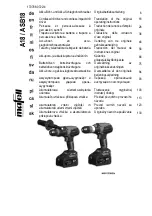
WARNINg! Ensure the drill is unplugged from the mains power supply before commencing.
6.1.
install drill bit
6.1.1.
Insert drill bit into chuck jaws to 1" (25mm) deep (avoid inserting small bits too far) and centre bit in chuck before tightening jaws
with chuck key.
6.2.
adjusting the table
6.2.1.
To adjust table up, down or round the column, loosen clamp bolt (fig.1.A). Move table to required position and tighten clamp bolt
(fig.1.A).
6.2.2.
To adjust table tilt, loosen the work table bolt (fig.1.B), adjust to the desired angle using the angle scale, then retighten.
6.3.
adjusting the speed
6.3.1.
Open the pulley cover and loosen the belt tension lock screw (fig.4.A).
6.3.2.
Choose the speed for drilling operation (see drill speed chart) and move the belt to the correct position for that speed, as shown on
the chart inside the pulley cover.
6.4.
Belt tension
6.4.1.
With the belt tension lock screw (fig.4.A) loosened the motor plate spring will automatically give the correct belt tension (belt give of
approx. 13mm under finger pressure). Tighten lock screw and close pulley cover.
6.5.
positioning the workpiece
6.5.1.
Use a piece of wood to rest the workpiece on. The drill bit may break through the workpiece and damage the table otherwise.
The wood should rest on the table so that one end of it is against the left side of the column. When the drill bit breaks through the
workpiece, it will contact the wood and cause it to spin. Resting the wood against the column will prevent this.
6.5.2.
For small workpieces that cannot be clamped to the table, use a drill vice (not included). Vice must be clamped or bolted to table.
6.6.
Setting drill depth
6.6.1.
Use the scale at the front of the drill head.
6.6.2.
Loosen lock nuts on threaded rod and adjust so that at desired drill depth, nuts contact head lug and prevent further drill movement.
Tighten lock nuts.
6.6.3.
When ready to drill, simply pull the feed handle. The drill feed will stop at the set depth.
6.7.
Guard
6.7.1.
Always adjust guard length, by loosening wing nut at each side (fig.5.A), to give maximum protection
before starting to drill.
6. OpEraTiNG iNSTrUCTiONS
Note: Figures are illustrative and may differ in detail from your drill.
5.1.
assembly
5.1.1. Place the column assembly on the base, align holes and secure with the three screws and washers provided.
5.1.2. Install the table onto the column and tighten clamp screw (fig.1.A).
5.1.3. Carefully place the head assembly over the column and slide it into position. Align head with base.
5.1.4. Tighten the two set screws in the right side of the head to lock it into position (fig.2).
5.1.5. Screw the three feed handles and knobs into the pinion shaft (fig.3.A).
5.1.6. To install chuck open the chuck jaws completely by turning the chuck key counter-clockwise. Place a piece of wood on the drill table
(to prevent the chuck from getting damaged).
5.1.7. Fit chuck to protruding end of spindle and hold in place (fig.3.B).
5.1.8. Turn feed handles to bring nose of chuck down onto wood (fig.3). Firmly pull on feed handle to seat the spindle taper in the chuck.
5.1.9. The safety guard mounting is pre-fitted to the drill head. Remove the three small screws in the guard support channel, insert the guard
and refit the screws, through the holes provided in the guard. Note that the guard is in two parts held together by two screws and wing
nuts. For packaging purposes these are supplied with the wing nuts on the inside of the guard. Before use remove screws and wing
nuts and refit so that wing nuts are on the outside and accessible.
5.2.
Drill mounting
5.2.1.
For stability and safety it is important
that the drill base is securely bolted to the workbench.
5.2.2. Ensure that the mounting surface is capable of supporting the drill together with the weight of the heaviest likely workpiece.
5. aSSEMBlY
fig.1
fig.2
fig.3
fig.4
Original Language Version
SDM30.V2 Issue: 1 - 30/06/11






















